
This post explores 15 major trends in B2C e-commerce, customer service, technology and platforms, payment options, and search, offering insights into improving online stores. Need a free consultation on the ecommerce trends 2024 that align with your business? Our seasoned team will help.
Reading time: 22 min.
According to Statista, ecommerce sales have surged since 2019 and continue to grow steadily each year. Experts predict a remarkable figure of $8,148 billion worldwide by 2026. This necessitates companies to think more holistically and plan their moves in advance. To increase earnings, capitalize on new opportunities. With an understanding of trends in this field, your online store can outperform competitors.
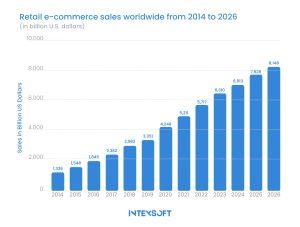
In this article, IntexSoft has uncovered the top 15 hottest online shopping trends. We invite you to explore what lies ahead in 2024 in B2C ecommerce, customer service, technologies and platforms, payment options, and search.
Let’s know the ins and outs of it!
How do we explain this effect?
When customers do part with their hard-earned cash, they want what they want, precisely when — and how — they want it. And knowing the maximum available product information, including all features and benefits.
The trend of high customer expectations requires integration between digital platforms and physical locations. If understandable and beautiful visuals were prepared creatively, life aspects added, and the link with offline channels thought through, it would all enhance the ROPO effect even more. Businesses will gain a powerful way to persuade potential customers to buy. Customers will research online and then buy offline in your specific store. This phenomenon has already been tested and always works flawlessly.
Remember, the ROPO effect’s impact may vary for different products. The categories most significantly influenced by ROPO include:
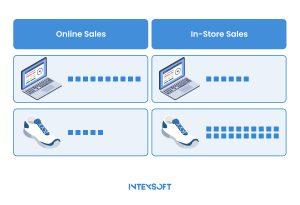
Consider this: consumers often prefer to touch, feel, or try on items like clothes, beauty products, and sports equipment before committing to a purchase. The reluctance to deal with the complexities of returning products through the mail or managing the return of bulky items, such as furniture, adds weight to the influence of the ROPO effect.
Yet, beyond mere common sense, there’s an emotional aspect at play. Consumers enjoy visiting a physical store, connecting with products, and purchasing in person.
Big data is a frequently mentioned term in the Internet business, encompassing vast amounts of structured and unstructured information generated by online purchasers. This includes browsing histories, purchase tendencies, customer reviews, and interactions via social media platforms.
In short, this is a goldmine for building revolutionary personalization strategies. The power enables businesses to understand customer behavior on an unprecedented scale. It delves into predicting their preferences, anticipating their needs, and providing a customized interaction at every contact point — from ecommerce recommendations to personalized content and targeted marketing campaigns. Tailoring products, services, and marketing efforts in real-time has never been so effective, and Big Data has made this possible.
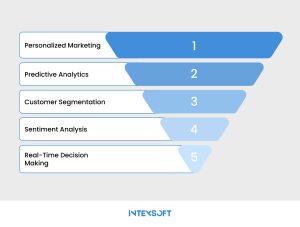
While the potential for personalization is vast, it also brings data privacy and security challenges. That’s why, in web development, there has been a leading trend for a long time — cybersecurity.
New rules, new forms. Ecommerce marketing has faced significant changes. The audience requires another engaging way. This is the moment where snappy videos come in as game changers.
They grab attention, convey messages, and amp up engagement in a few seconds to a minute. The wild popularity is explained by mobile devices and social media high positions. TikTok or Instagram Reels are important in popularizing short videos.
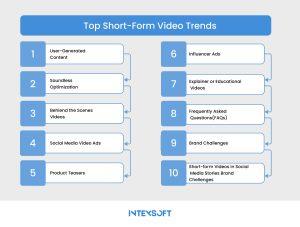
The rapid accessibility and immediate impact of short-form videos make them a distinctive asset in ecommerce marketing, offering a unique and engaging avenue to connect with and captivate audiences. They provide a swift and immersive way for consumers to experience products, cultivating a sense of connection and urgency. These videos promote flash sales, product launches, and special deals, steering traffic and conversions in real time.
Moreover, the interactiveness of this type of content facilitates close engagement with the consumers. Features like comments, likes, and shares foster a two-way conversation.
This cutting-edge trend amplifies the shopping path by integrating digital elements into real life. Thanks to Augmented reality applications, consumers can virtually test out clothing, envision furniture placements in their living spaces, and even preview how cosmetics complement their faces before committing to a purchase.
This interactive approach adds a tangible dimension to online shopping, offering customers an enhanced understanding of products and a heightened confidence in their purchase choices.
This trend integrates real-time interaction, transforming the consumer experience. Brands showcase products, engage with customers instantly.
Thanks to this approach, brands can showcase products, highlight features, and directly engage with consumers innovatively. The immediacy of this real-time interaction closes the divide between digital and in-person shopping encounters, enabling customers to ask about what they need, look for advice, and receive instant feedback. The result is a more personalized and engaging shopping environment.
Particularly impactful in industries like fashion and electronics, live streaming transcends borders, connecting businesses with a global audience.
Although same-day and next-day delivery services may not dominate the front pages, they remain a topic of interest for most customers. Delivery speed and flexibility can become important factors when buyers decide where to make online purchases and which websites to avoid.
A key advantage of expedited delivery lies in its impact on customer satisfaction. The ability to receive a purchase on the very next day elevates the overall shopping experience. As a result, you will gain customer loyalty and create a positive brand image.
The crux of chatbots lies in integrating artificial intelligence and natural language processing. As a result, these intelligent tools not only understand but also respond to customer queries. Each response is unique, offering human-like and customized support.
A significant leap is the capability of interactive chatbots to tackle intricate problem-solving. No longer confined to rule-based responses, today’s chatbots can analyze complex issues, provide detailed information, and guide customers through multi-step problem resolutions. Customers can now independently find answers to their queries, troubleshoot problems, or gather information 24/7.
Remember, interactive chatbots seamlessly navigate various communication channels, whether it be mobile app, website chat or any social media.
Advanced chatbots leverage customer data to anticipate needs, offer personalized recommendations, and even initiate conversations based on user behavior.
Businesses can forge direct connections by harnessing platforms like social media, chat applications, and messaging services, delivering a personalized touch that goes above and beyond expectations.
Direct messaging is the ultimate avenue for intimate one-on-one communication between businesses and customers. This direct channel empowers customers to seek assistance, pose inquiries, or provide feedback seamlessly. The real-time nature of this trend stands out as a pivotal advantage.
Customers have a wiggle room to select their preferred mode of communication through direct messages on social media, popular messaging apps, or other dynamic tools. Businesses can meet customers where they are and enhance inbound marketing strategies simultaneously.
We have to acknowledge direct messaging isn’t a novelty among digital commerce trends in customer services. Many companies have already used it; it’s almost ubiquitous. In this post, IntexSoft has highlighted this trend to emphasize that it is not just an alternative opportunity but a necessity in 2024 if your business aspires to thrive.
Traditionally, ecommerce platforms operated within a tightly woven structure, where the frontend and backend were intricately connected. Headless Commerce disrupts this norm by separating the presentation layer from the underlying functionality. This shift liberates businesses and opens the door to experimentation, allowing for introducing new features more quickly and straightforwardly.
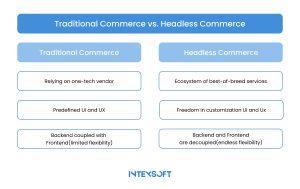
The headless nature is crucial for the future of ecommerce apps. Only in this way can your developers keep up with the 21st century, adapt to consumer expectations, and respond to market trends. Integrating innovative solutions without a complete architectural overhaul becomes much faster and easier. Assess it.
Are you seeking a strategic move for your online store? There’s a game-changer that’s making waves – Composable Commerce.
This trend discards the rigid, all-in-one system for a modular setup. Each block represents a specific e-commerce function – think catalog management, checkout, and payments – and businesses can mix and match these blocks to create their own unique setup. The beauty is that they can switch out, upgrade, or add new blocks without dismantling the entire structure.
But that’s not all. Composable Commerce aligns perfectly with the trend toward personalized customer experiences. By integrating specialized solutions (Headless Commerce and API-driven architectures), businesses can create a unique online presence to enhance sales.
The secret to winning customer loyalty is diversifying payment methods and catering to a broad spectrum of preferences and habits.
The era of applying a universal solution for all situations is no more. Modern consumers desire flexibility and options when it comes to making online payments. By providing a range of payment choices, stores not only meet customer expectations but also create a user-friendly atmosphere that encourages repeat business.
Expanding payment methods extends above debit or credit cards. While these are still essential, integrating alternative options has become more important than ever.
Consider the following:
Popular payment methods
| Payment method | Description |
| Digital wallets | Google Pay and Apple Pay are about quick and very well-protected purchase methods without entering extensive details. |
| Buy Now, Pay Later (BNPL) services | They provide the convenience of deferred payments, allowing customers to divide their purchases into easily manageable installments. |
| Cryptocurrencies | You gain fantastic decentralized and borderless payment options. |
In the previous point, we discussed the diversity of paying methods; now, let’s pay more attention to BNPL services because this technology is worth implementing. It truly stands tall among trends in the ecommerce industry.
At the core of BNPL services is the option for customers to defer their payments, typically breaking down the total cost into manageable installments.
But why has this method become highly popular? To answer this, we need to look at the Statista data. Although the data is not from 2024, you can understand the dynamics with these insights.
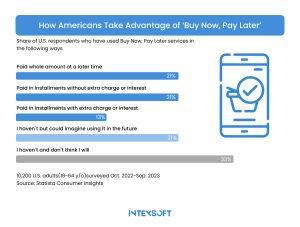
Here are two factors that contribute to the rise of BNPL services:
Remember, offering this payment option not only attracts a broader audience but also fosters customer loyalty by providing a payment alternative.
Visual search is an exciting technology that is transforming how we discover and explore products or services. Finding products using images instead of traditional text searches is much more convenient. By identifying objects, patterns, and specific attributes within pictures, ecommerce platforms maintain high efficiency.
The customer journey becomes more enjoyable, allowing shoppers to upload an image or use a photo they’ve taken to find similar products across different online stores. It’s an intuitive way to discover items you love.
Furthermore, visual search addresses the challenge of accurately describing products in words. There’s no need to struggle with text queries; AI will handle this for you. Rely on images to show what you’re looking for.
Retailers embracing this technology are not just keeping up; they have a significant advantage over competitors.
After the digital revolution, customers no longer confine themselves to just one platform when searching for products or services; instead, they explore various channels such as search engines, social media, and dedicated online stores.
Imagine a customer commencing their journey by searching for a product on Google, scrutinizing reviews and recommendations on social media platforms (Instagram, primarily), and ultimately purchasing on your online store. This approach can be termed multi-platform, showing no signs of slowing down. Sometimes, it is called federated search.
For business owners, this signifies the necessity to establish a presence across these platforms. It’s an integral part of success. Ensure that your business is easily discoverable when customers are searching. Evaluate whether your app is convenient for buyers.
In today’s digital age, your online search experience is like having a personal assistant who knows you well. Forget about getting generic search results that don’t quite hit the mark—now, search engines are all about giving you exactly what you’re looking for.
Picture this: you type in a search, and instead of sifting through irrelevant stuff, the results are tailor-made for you. It’s like the search engine knows your favorite topics, past searches, and even where you are. This magic is made possible by intelligent algorithms that analyze your online habits.
Your online journey becomes smoother and more enjoyable because you’re not just another face in the crowd.
Businesses are jumping on the bandwagon, too. We advise you to tweak your store’s content to ensure it pops up in searches that match what every specific customer is into. So, consider this when assessing online retail trends.
B2C e-commerce, customer service, technology and platforms, payment options, and search are essential to ecommerce success. Collectively, they paint a picture of the industry’s trajectory. By knowing recent novelties in this field, you, as a business owner, can come up with original ideas and work at 100 percent capacity. The end goal is maximum profit.
While some of the latest ecommerce trends mentioned are still in their early stages, they are swiftly progressing and significantly influencing the future of online store development. This presents a golden opportunity for business owners to create innovative and user-centric apps that can fully unleash the potential for increased sales.
In essence, the e commerce future trends revolve around a more personalized approach, and this transformation is unfolding as we speak. All trends are connected with this. Being at the forefront of a customized approach is vital for maximizing productivity.
To stay ahead, consider contacting IntexSoft experts for a free consultation. Doing so will equip you with the best practices to attract and engage new customers.